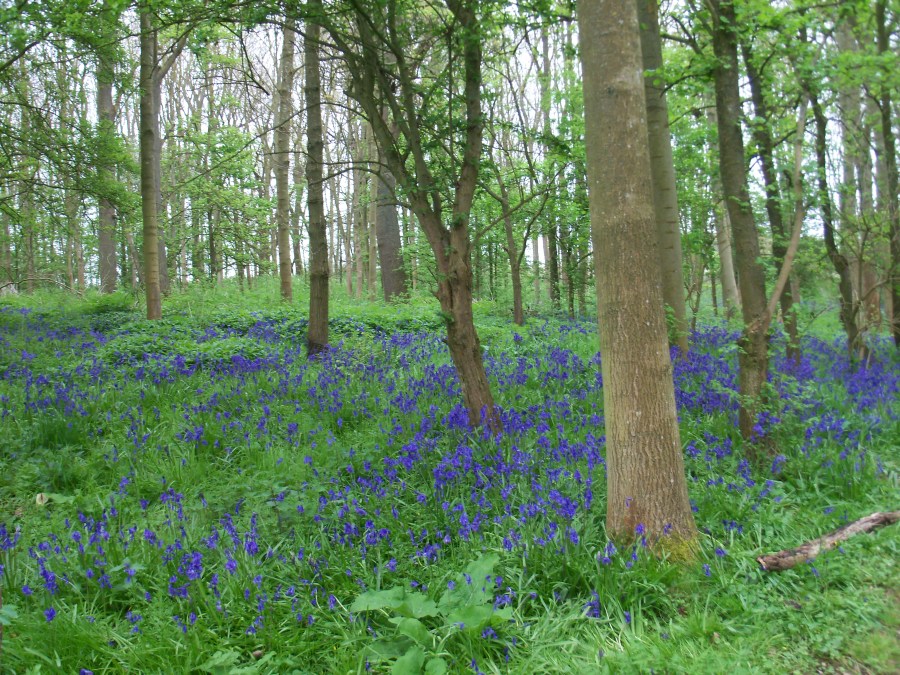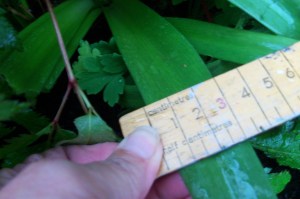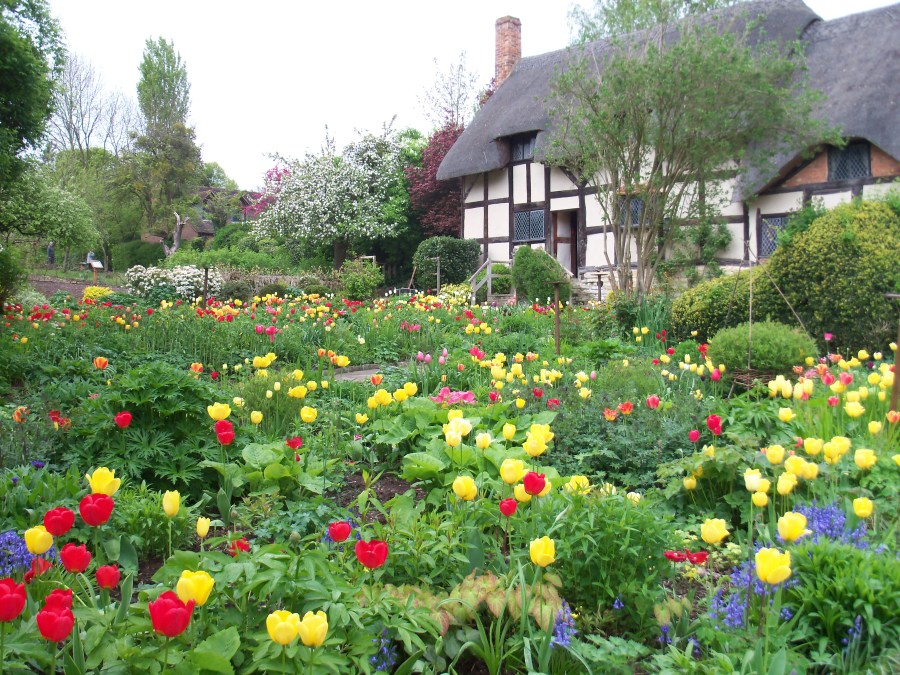There is little to compare with the vista and fragrance of an English wood in late April and May than the sight of our beautiful native bluebells (Hyacinthoides non-scripta) in full bloom and now is the time when one of the UK’s favourite flower begins to appear across the UK. However, people often get their knickers in a twist when someone mentions “Spanish” bluebells, those pale hybrids seen in gardens and growing in woodland, demanding these invaders be ripped out and destroyed, claiming the end of the world is nigh for our natives with these upstarts taking over.

In this post I will show how to correctly identify English native bluebells from hybrid ones (Hyacinthoides x massartiana) often, although incorrectly, called Spanish bluebells (more on this later). I’ll explain how to remove unwanted ones from your garden, exploring the misunderstanding surrounding them together with a few facts and figures.
But first, what makes me an expert on the subject? Whilst I may not hold a degree in scientist or botany, I am a gardener of many years standing (or should that be “bending”?) with bluebells in my garden. I’m a lover of the natural world and nature, and a professional artist who paints countless pictures of bluebell woods and landscapes. In pursuit of this art, I have visited many woodlands, studied and researched these plants in depth in their natural habitats and am well-read on the subject, keeping up-to-date on the science.
So…. it’s early Spring. March, possibly early April. Leaves are beginning to appear on the woodland trees whilst beneath, the woodland floor is swathed in flowers. They are blue, bell-shaped and blooming in the woods, therefore they must be English bluebells. Correct? Not necessarily. They could be hybrids, which are known to grow faster and often flower earlier than the native kind. But are they bad boys so many people believe? And how do you tell difference between the two? There are several ways one can correctly identify an English bluebell from a hybrid.

Native Bluebells (Hyacinthoides non-scripta)
- The flowers are long, tubular bells and a deep blue/violet colour. Occasionally they can be white, rarely pink – both genetic mutations (“sports”).
- The petal tips are fully reflexed, that is curled back to almost touch the bell itself.
- The flowers hang down on one side of the dropping stem.
- The flowers are sweetly scented.
- The anthers inside are either white or cream.
- The stems are thin, the leaves narrow, about 1-1.5 cm (half-an-inch) wide and often laying flat once the flowers are open.
- The natural flowering time is in late April and May, although this can depend on the location in the UK and the weather. Typically, here in the West country, they appear from mid-April on in sheltered areas.
Hybrid Bluebells (Hyacinthoides x massartiana)
- The flowers are pale blue but can be pink or white.
- The flowers are large, conical and bell-shaped with the tips splayed out like a bell.
- The flowers hang all around the upright stem.
- The flowers have no scent or some would describe an unpleasant “onion” whiff.
- The anthers are either blue or green.
- The leaves are broad, about 3cm (1 inch) wide, and the thick stem can be well over 35cm (14 inches) tall.
- They are often in flower before Hyacinthoides non-scripta.


H x massartiana is a hybrid that has crept into our woodlands. It is a cross-breed between Hyacinthoides hispanica (the Spanish bluebell) and our own native H.non-scripta. The true Spanish bluebell H.hispanica is rarely if ever found in the wild in the UK nowadays but can still be found in gardens – I have them in mine , they self-seeded from a neighbour’s garden but I don’t mind them. They’ve never been a problem for me.

The Spanish bluebell H.hispanica was introduced to UK gardens more than 300 years ago. It quickly became popular as it was believed it had increased vigour. What it did have was the ability to escape the confines of gardens and crossbred with our native H.non-scripta and thus created H x massartiana. This was perceived as a big problem because hybrid plants have the potential to eventually overtake native species. However, today’s scientists and current research have revealed it is not the end for our natives and that fears the English bluebell could go extinct are unfounded according to many scientists and botanists.
The greater threat to our native bluebell is the destruction of its natural woodland habitat by developers and builders, railway track laying and road building, coupled with unscrupulous plant collectors who gather the bulbs to sell to unwitting gardeners.

It has been proven the hybrids are not as vigorous as once thought, with the natives holding their own in woodlands in locations across the UK despite around one in six broad-leaved woodlands containing the hybrid species. It has been found the introduced Spanish variety has lower fertility and is unlikely to wipe out the native plant, according to genetic tests. It turns out that the British bluebell has a genetic advantage. As one study showed:
“In research to look at the potential genetic threat, the Spanish bluebell was planted next to the British bluebell in large numbers and allowed to breed naturally. The native bluebell was more fertile and set more seeds than the Spanish bluebell, saving it from the threat of extinction by hybridisation. It appears that the Spanish bluebell may already be a hybrid, with reduced fertility, even though locally it can escape, spread and be hard to remove from gardens. When examined, the pollen of the non-native bluebells in the UK was often misshapen – indicating lower pollen fertility, compared to the pollen of the native bluebell.” (Dr Deborah Kohn of RBGE)
When one takes into account the fact these Spanish ones have been escaping for 300 years and the fact our natives still going strong, it bears out these observations: hybrid bluebells are not the rampant aliens so often claimed. I have non-native bluebells, blue and white, in my garden. Some have been growing here for nearly 50 years. They have neither spread nor taken over. Not 100 yards from my front gate is a patch of wild woodland which is full of native bluebells now just coming into flower. And mine isn’t the only garden hereabouts that has the Spanish variety. Speaks volumes to me!

Prof Hollingsworth, Director of Science at the Royal Botanic Garden Edinburgh (RBGE) says: “The greater fertility of the native British bluebell coupled with the huge numbers of individuals that exist in the wild means that it’s got considerable resilience against any threat from these introduced plants.”
So isn’t it about time people put an end to the constant war and bickering over these plants and let us enjoy them for what they are.
Bluebells and the Law
What are the rules about picking bluebell flowers? Under the 1968 Theft Act and the 1981 Wildlife and Countryside Act, it is illegal in the UK to: “pick, uproot or destroy any wild plant without permission from the landowner or occupier, that also includes flowers growing on National Trust properties”. Whilst it is not normally an offence to pick fungi, fruit, foliage or flowers if for your own use and not personal sale, there are many rare and endangered specials that are protected under the Wildlife & Countryside Act, and you could face arrest. The native bluebell falls into this category. It is also an offence to plant hybrid bluebells into the wild.
Removing from your Garden
You may have hybrids (or natives) in your garden you want to remove. Unless you want to resort to weedkiller or salt (snap off flower stem and poor a little salt into the hollow stem) they are not easy to eradicate but they are easy to control – simply remove the stem once the flowers have finished and before they have set seed. Pulling out by the leaves and stem is not enough because the bulbs go down far into the soil. The only way is to dig down deeply to reach and remove the bulb. Sometimes a small piece remains and will grow back but again, it is simple to control and contain. If you do have true natives you want to remove, it is worth approaching garden and plant suppliers or other gardeners to ask if they want them. Whatever you do, do not plant back out in the wild without the landowner’s permission and ensure they are 100% H.non-scripta. Better still, contact your local council or wildlife group first before you consign them to a compost heap or dustbin.
I can understand why people dislike the hybrids — they are not as pretty or perfumed like our own native bluebell, and many people still believe they are an environmental threat. They are not! Even National Trust gardens grow the non-natives. A few years ago I had the pleasure of visiting Anne Hathaway’s Cottage in Stratford-upon-Avon. The gardens there were full of them blooming amongst a lovely show of spring tulips, yet within the grounds were swathes of lovely native bluebells.

There is nothing wrong with non-native bluebells if you like them, indeed they are a pretty flower and if you want them in your garden, fine. Of course, if you rather the native variety in your garden, most plant suppliers sell the true natives. Just ensure they come from a sustainable source and are not dug up from the wild.